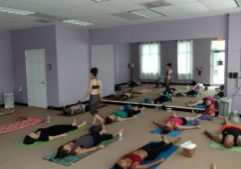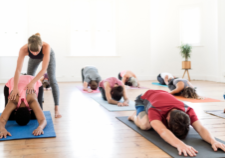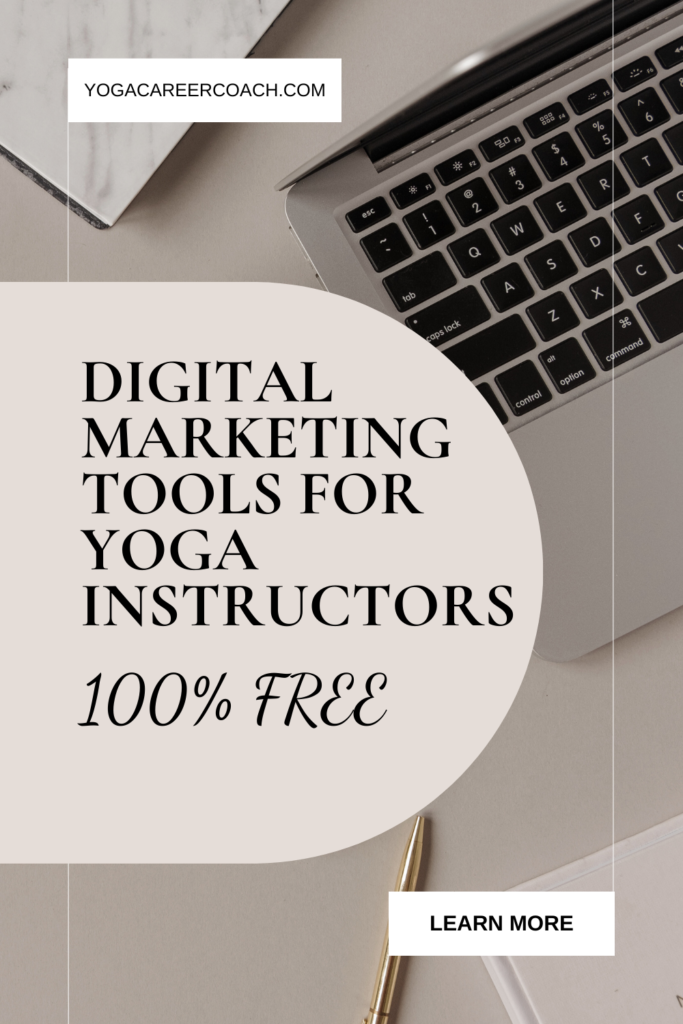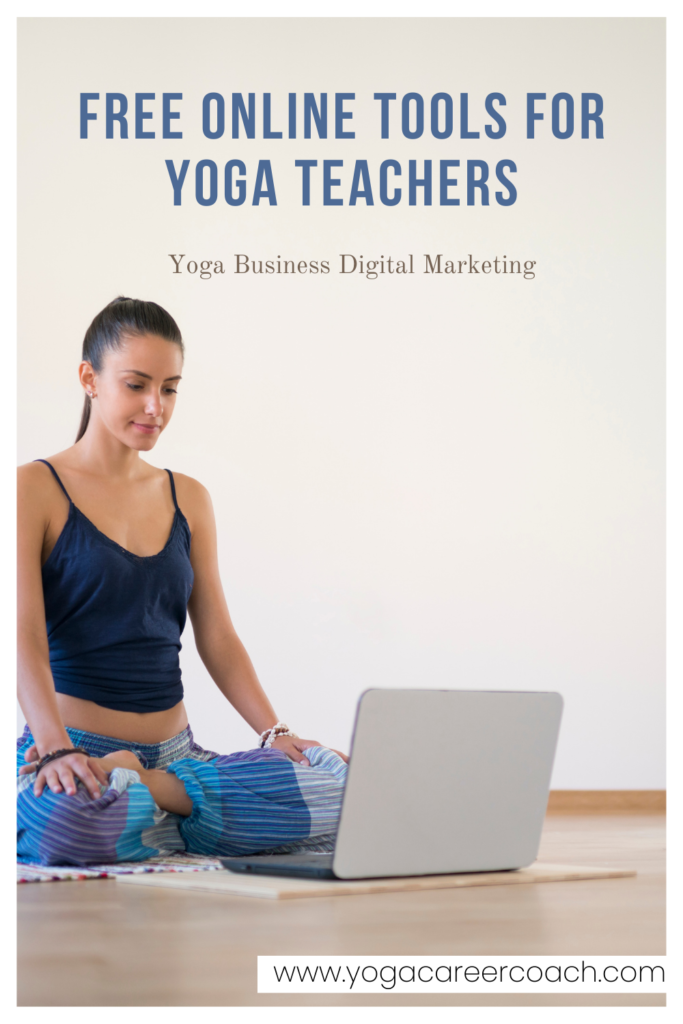Free Online Tools Every Yoga Teacher Should Be Using

We know the internet and digital marketing can be so daunting to yoga teachers. We are used to feeling and connecting in person, which is so important. However, in this day and age utilizing the internet and all the tools that come with it are essential to a successful yoga business. Showing up online doesn’t have to mean positioning constantly on social media. There is so much more to the internet and the great digital tools available to yoga teachers, and for free!
We will break down some of the most essential free tools that yoga teachers can take advantage of that will help in all aspects of your yoga business.
The Google Suite
Google isn’t just the search bar that opens up when you go online. Google has an entire suite of multiple useful tech tools that are all free to users. And you should take advantage of most of them, if not all. You can easily get away with using the Google Suite and just a few other tools to get your yoga business off the ground.
Gmail

If you’re going to make use of the Google suite apps, you need to start with a gmail account. Once you create your free google account you’ll have access to all tools available. Gmail is an email platform but you can integrate the other tools inside of your gmail account. Inside your email you can do things like set up a signature, set up templates for emails, create tasks based on the email you are in, take notes, and create calendar events all from your inbox.
Google My Business

We can do a whole blog just on Google My Business. If you are teaching yoga locally you NEED a Google My Business page. This is what pops up when you search for things on the google when it’s a local business. It will usually pop up on the first half of the page on Google. So, even if your website doesn’t pop up on the first page of Google, your Google My Business Page might.
On your Google My Business profile you promote your business to potential yoga students in your local area. You can share your website, phone number, photos, a direct way to book and more.
You’ll want to really fill out this page with as much detail as possible and SEO techniques. As you can see on my profile I specifically write in Private Yoga Instructor into the title of my page. So if you’re a sound healer, be sure to write that in, or a yoga retreat facilitator, community yoga leader. Whatever your niche is you’ll put that in here. Be careful not to “keyword stuff” which means just adding in words you think people will be searching for, Google does not like this and you will be penalized.
This is also where you can get your students to write you a review, the more reviews you have the more likely your page will be displayed.
Google Drive
Google Drive is like Microsoft Office but it’s online, completely free, and saves your work automatically as you go along, so you never have to worry about it crashing and you losing all your work.
You have Google Docs which you can use for all your yoga digital marketing documents as well as lesson planning, writing your resume and cover letters, bios, writing out the draft of your blogs and so much more.
Then there’s Google Sheets, think Excel. This is where you can write out your budget, keep track of your expenses and finances, and I even use it to keep track of all the events we teach at my yoga business.
There is also Google Slides, which is like Powerpoint. Here you can plan out lessons for any virtual sessions that you teach or if you’re planning on creating youtube videos with information slides and more.
Google Forms
Google forms is where you can create free forms, surveys, and even quizzes. You can use this as an intake form for your yoga students, or a feedback form for your group classes, and much more.
Forms are an essential part of having a yoga business, you’ll want to get feedback often so that you can continue to improve your business.
Digital Yoga Marketing Tech Tools
Social Media to Utilize: Youtube, Pinterest, Instagram, Facebook
Yes, we all know about social media. Sometimes it’s overwhelming to be active there since there’s so much noise already. However, it is important to show up somewhere on social media so that your students and potential students can learn where to find you and take yoga with you. When people are searching for yoga, especially your niche you want to have the best chance for them to find you and social media is where a lot of people are.
Depending on what you’d like to do with your yoga business you’ll want to choose at least a couple platforms to use. Here at Yoga Career Coach we love Pinterest, Youtube, and Instagram.
Be sure to post with purpose, this will make it less overwhelming and more quality.
Canva: Crafting Engaging Visuals
Canva is a free design platform where everyone will feel like a graphic designer. Canva has templates where you can create flyers, social media posts, and even videos. There are graphics, photos, stickers, and more that you can use for free. The paid version gives you even more options. We recommend using the free version until you feel you really need all the paid features before making the switch.
One mistake we see often is yoga teachers not having professional or modern looking flyers or images to promote their classes or themselves. Canva will help you create stunning images to enhance your digital marketing efforts with ease.
Pexels: Free Images
Technically, you cannot just take photos from the internet and use them on your website, or in your flyers to promote yourself. You need permission, this is where Pexels comes in. Pexels is a free platform where you can get professional stock photos that are marked as fair use, meaning you can use them to promote your yoga business.
When you’re ready to take your yoga business to the next level you can buy the paid version of Canva and you can access tons of better quality professional stock photos. But again, use every platform's free version until you know it’s time to move on to the paid version.
MailerLite
If you aren’t already collecting emails, start now, this is the Business of Yoga 101. Every yoga business owner needs an email list. This list is invaluable. When you’re solely relying on social media, or even google for your visibility you put your destiny in their hands. Whenever Meta or Google decides to change their algorithms or rules, your business can suffer. The email list is yours to own, a direct way for you to communicate with your yoga community.
MailerLite offers a pretty robust system for free up to 1,000 subscribers. So, start here, you can send emails, create landing pages, and popups for your website all through MailerLite.
Class Delivery Tools
Video Calling Platforms
Zoom became popular during the pandemic as a way to hold virtual yoga classes. This is still a great platform to use for your virtual yoga sessions. The free version allows you to hold a 40 minute call for up to 100 attendees, for a 1:1 session it is an unlimited time. So, if you’re wanting to hold a 60 or 90 minute session, you’ll want to go with the paid version or use another platform like Google Meet.
Speaking of Google again, Google Meet is an alternative to Zoom that’s completely free. You can hold a 60 minute session with 100 participants or an unlimited time for 1:1 meetings.
Teachable: Creating Online Course Offerings
Teachable is a great tech tool if you are planning on creating an online course or have a membership. The free version is limited, you can have one admin user, one course, and one digital download.
Facebook Live: Promoting Social Engagement
Facebook Live is your window to the yoga community. A live Q&A session, a quick yoga routine, or a talk on the benefits of yoga—anything that can stir up some engagement is perfect for Facebook Live.
Researching and Education Tools
When growing your yoga business, research and education is essential. However, you don’t necessarily need to take a bunch of highly priced teacher trainings and workshops, and buy a ton of yoga books. We do recommend those, if they are in your budget of course. When your budget is tight or for day-to-day research and education, you can utilize free online tools.
Youtube
Youtube is the Google of videos, it is owned by Google afterall. Anything you want to learn about, guaranteed there is something about it on Youtube.
You can research specific topics of anatomy to learn more and be more informed, you can also learn things specific to yoga teachers, (be sure to follow us) or even take yoga classes. It’s always good to try new yoga classes with new teachers, and Youtube has an abundance of classes by an abundance of teachers. If you plan on creating Youtube videos for your yoga business, being on the platform as much as you can will help you learn how it works and give you some inspiration for your own videos.
Spotify
Spotify is mainly used to make playlists and they have a plethora of already created yoga specific playlist created not only by Spotify itself but the thousands of users as well. However if you're going to be using the music side of Spotify you’ll need to use the paid version, since there are ads in the free version.
But, Spotify is also home to hundreds of podcasts, and podcasts are a wonderful way to learn. There are so many yoga and business podcasts that you can learn from. Pop it on as you commute throughout your day or doing your household chores, passive learning and multitasking at its finest.
Spotify
Libby is where the library meets the internet. It's an app that has digital downloads as well as audiobooks that you “check-out” with your local library card number. Another great way to learn for free, get yoga related books to listen to for free as you commute or however you like to consume audiobooks.
Since this free content is provided by the library system there may be a hold time on books, so we recommend placing a hold on a few books at a time so that you can be in the queue for more than one and you don’t have to take a break in between your learning.
Yoga Alliance
Although a membership with Yoga Alliance isn’t free, if you are paying to be registered there anyway, you should take advantage of everything they have to offer. There are a ton of free workshops and webinars on the site as well as discounts offered for yoga related products and services. New teaching guidelines, yoga-related research, or peer networking—Yoga Alliance continues to be an invaluable resource for both seasoned and novice yoga teachers.
Free Yoga Website Hosting
All yoga teacher business owners need a website. Like your email list, your website is something you can have full control over. When you have a site, your business seems more legitimate and professional. Having a website is a great way for potential yoga students to not only find you but get to know you better.
Platforms like Canva and Mailerlite offer free website hosting that is user friendly. WordPress is also free site hosting that is a little more technical but you have much more control over what you are able to put on your site.
Canva is one of the only sites that offer a free domain as well as hosting. So, if you’re starting from scratch go with a Canva site just to get something up and get your feet wet. Then, when you are ready you can get a WordPress site or purchase from Wix or Squarespace.
Finances and Payment Tools
Yoga may be priceless, but teaching it isn't. Wave, Venmo, PayPal, and Stripe can make handling finances easy. Whether for managing invoices, receiving payments or keeping an eye on expenses, these tools really know how to show you the money.
Venmo, and Paypal and Stripe are great ways of accepting money from clients. But, Wave is probably the most robust platform you can get for free. Wave offers invoicing, payment links, recurring payments, finance tracking, and even payroll. This is a great all around platform, especially if you want to set up a membership or work with corporate clients who will most likely need easy invoicing. There is a fee charged with every transaction on Wave but that is just the cost of doing business and you may want to incorporate that into your pricing.
Productivity
When you start transitioning from yoga teacher to full blown yoga business owner you’ll want some help with productivity. Clickup, Asana, Pomodoro Timer are all great ways to keep you productive for free. Clickup and Asana are free platforms where you can set up goals and tasks for yourself and your business. The Pomodoro Timer is a way to keep you focused and productive for a certain amount of time, then gives you the option to take a break. With a wide array of free productivity tools available online and even in apps, you can pick the one that resonates with your workflow.
The Importance of Tech-Savvy Yoga Teachers
Being a good yoga teacher is amazing and needed for a strong yoga business, but you can be the best teacher on the planet but if you aren’t able to run a business digitally you’ll find it hard to become a full-time business owner. Whereas at the same time, if you’re a good business owner but don’t spend any time working on your actual yoga teaching skills, you’ll also have a hard time creating a successful business. This is the Business of Yoga 101 as well, these two go hand in hand and it’s our job to find the balance between the two if we want to be successful yoga business owners and entrepreneurs. It isn’t easy but with the right passion and motivation, you can do it! As always, find your Why and remind yourself of it daily to keep yourself motivated through the rough patches.
Remaining Open to New Tools and Trends
Finally, always be on the lookout for new tools and updates. Your favorite tool today might be superseded by something even better tomorrow. Keep learning and adopting, because like yoga, the digital world is all about continuous growth and evolution.








